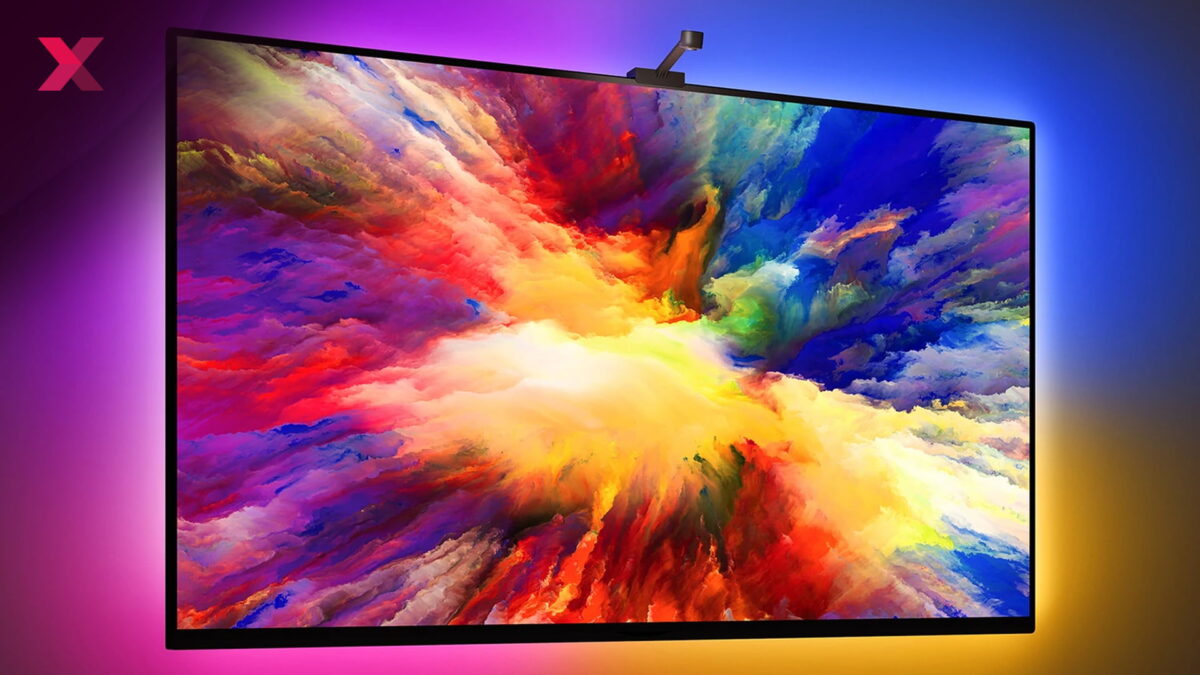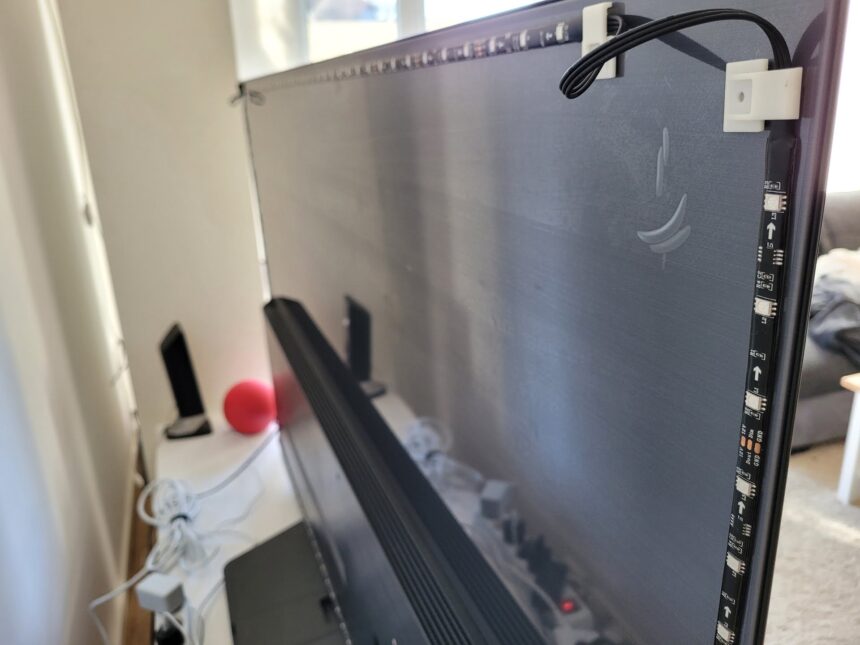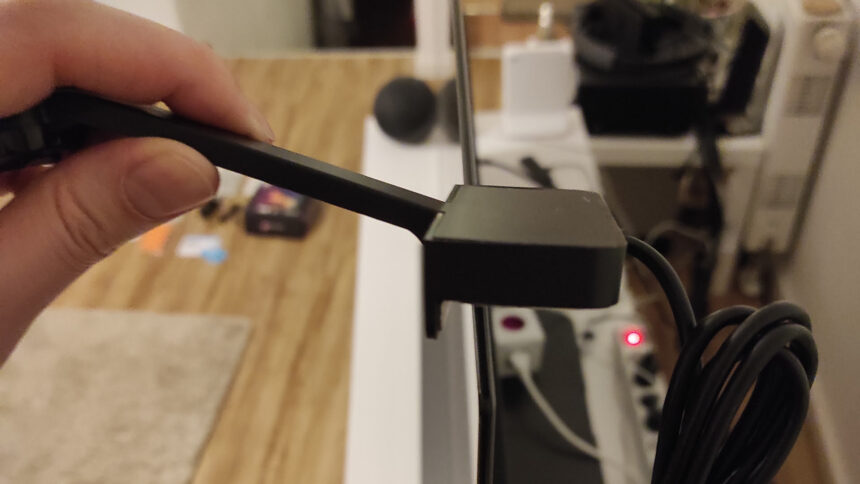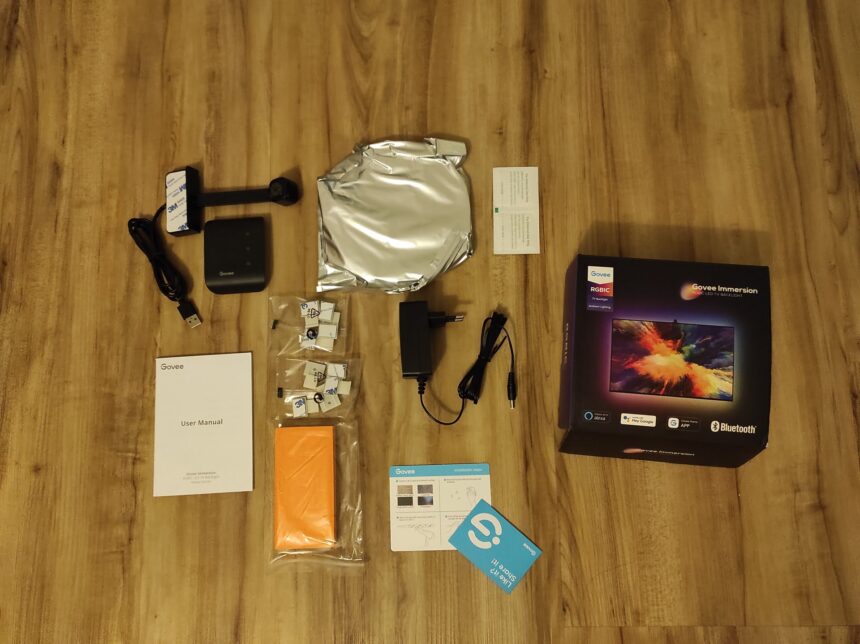Ambilight retrofit: Govee Immersion TV Backlight review

The Govee Immersion TV Backlight is an affordable alternative to the Philips Hue Play Gradient Lightstrip. Our review shows whether saving on Ambilight is worth it.
Invented by Dutch tech contender Philips, Ambilight is designed to enhance the TV experience. The color gradients of the TV picture are extended to the wall by a smart light in real time. Originally only installed in smart TVs from Philips, Ambilight can now be retrofitted.
Signify currently offers the premium solution with the Philips Hue Play Gradient Lightstrip and the HDMI Sync Box. For an impressive price of about 400 Euros, smart tech enthusiasts get beautiful colors and excellently manufactured hardware. However, the Philips Hue system also has its flaws.
The Chinese manufacturer Govee offers a much cheaper camera solution with the Govee Immersion RGBIC LED TV Backlight. Losses in picture quality, which can occur with Philips Hue when the signal is looped through to the Sync Box, are theoretically eliminated here. How does the budget Ambilight perform in the practical test?
Content
Govee Immersion LED TV Backlight - Review in a nutshell:
The Govee system responds quickly, offers extensive setting options and can be used flexibly. The camera solution has advantages and disadvantages. However, it is hardly suitable for narrow Smart TVs. In terms of color brilliance, Govee does not come close to Philips Hue, but it is still the clear price-performance winner.
Advantages of the Govee Surround Light System
- simple operation
- short reaction time
- extensive setting modes
- no influence on picture quality (TV signal does not have to be looped through a sync box)
- light tube optionally reacts to music via cell phone mic
- very good price-performance ratio
Disadvantages of the Govee Surround Light System
- clunky camera
- not suitable for narrow TV frames
- complex calibration process
- Colors less brilliant than competitors
Installation and configuration: time-consuming
Govee's solution, unlike the Philips Hue Gradient TV Lightstrip, wraps around all sides of the TV but skips the corners. The finger-wide light tube comes on a spindle and is stuck to the back of the TV as it unrolls. Problem areas can be additionally fixed with small plastic holders.

The Govee Immersion TV Backlight is glued to the back of the smart TV. | Image: MIXED
Govee uses a camera to analyze the TV image, which must first be calibrated. To do this, you stick small foam cubes to the edges of the screen. The adhesive leaves no residue if you only press the cubes lightly and remove them immediately after calibration. The area to be scanned for the camera is defined via the Govee app using the cubes. The whole process takes a bit of time, but it is neatly explained and thus easy to perform.
Tip: Colorful decorations should not be placed too close to the TV. I had the Red Edition of the Echo 4 (review) next to the screen at the beginning and then wondered why the color gradient is always bright red.
The clunky camera is not very pretty
The camera's design is very bulky. Anyone who wants to hang a particularly elegant smart TV on the wall will be put off by this clunky beater. The mount is also not very well thought-out. Modern smart TVs usually have very thin frames. However, the holding surface of the camera is rather designed for wide frames.

The design of the camera is not very well thought out. It cannot be attached to a thin smart TV. | Image: MIXED
I can't attach the camera to my LG OLED smart TV. Fortunately, the system also works if you place the camera centrally under the screen. However, this is not really explained in the product description. Only during the calibration process in the app can I set whether the camera is placed at the top or bottom.
Operation, comfort & range of functions are excellent
The already mentioned Govee Home app is tidy and easy to use. There are controls for saturation and white balance, relative brightness or a gradient setting where I can individually adjust the luminosity for individual segments of the light tube. The immersive light reacts either to the TV picture or to music.
For the video function, movie and game options are selectable, as well as a rigid ("all") or flexible ("part") color mode. In "All" mode, the backlight picks the dominant color in the image and applies it to the entire tube. For example, if you have a scene that shows a large blue mountain lake surrounded by a meadow, the light around the entire TV will shine blue. In "Part" mode, the light tube takes over all the colors. If the meadow is on the right edge of the screen, for example, it radiates away green on the right, while yellow sunlight might be expanded at the top edge, and the brown of a dirt road on the left.
The TV Backlight can also be used without TV synchronization. Govee offers many different predefined scenes, categorized as Natural, Festival, Life, and Feeling. You can also create and save your own scenes. The basic functions can also be performed via voice commands using Alexa or Google Assistant.
Review summary of the Govee Immersion TV Backlight
The Govee system responds lightning-fast and latency is barely noticeable. Setup and control via the smartphone app run smoothly, and operation with voice assistants like Alexa and Google Assistant also works excellently.

Those who want to retrofit Ambilight will get a decent system at a small price with the Govee Immersion TV Backlight. | Image: MIXED
The camera solution has its advantages: I don't have to loop the signal through an additional box and can thus use the surround light even with content that comes from native smart TV apps. With a sync box, such as Philips Hue offers, the signal has to come from an external receiver or streaming stick and the picture quality can suffer.
The disadvantage of the camera is that it is clunky and not suitable for smart TVs with particularly thin bezels. If you have your TV on a TV board, you can at least still place the camera in front of the screen. The only solution for wall mounting is a DIY solution.
The color brilliance cannot keep up with the Philips Hue Gradient Lightstrip TV, but it still does well. In the version for smart TVs up to 65 inches (1.65 meters), Govee only charges around 80 Euros for its system - a clear price-performance recommendation.
Read more about Ambient Computing:
- Eve CEO Jerome Gackel: Matter is a gamechanger for the smart home
- Smart Home: Which devices support Matter?
- Google Home Mini officially discontinued - the end of an era
Note: Links to online stores in articles can be so-called affiliate links. If you buy through this link, MIXED receives a commission from the provider. For you the price does not change.